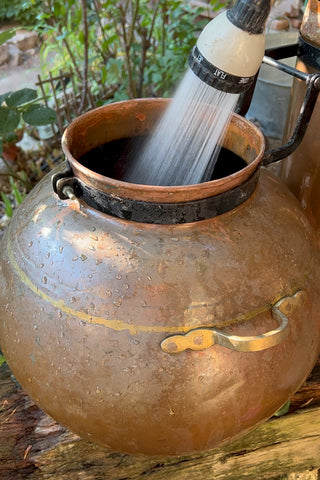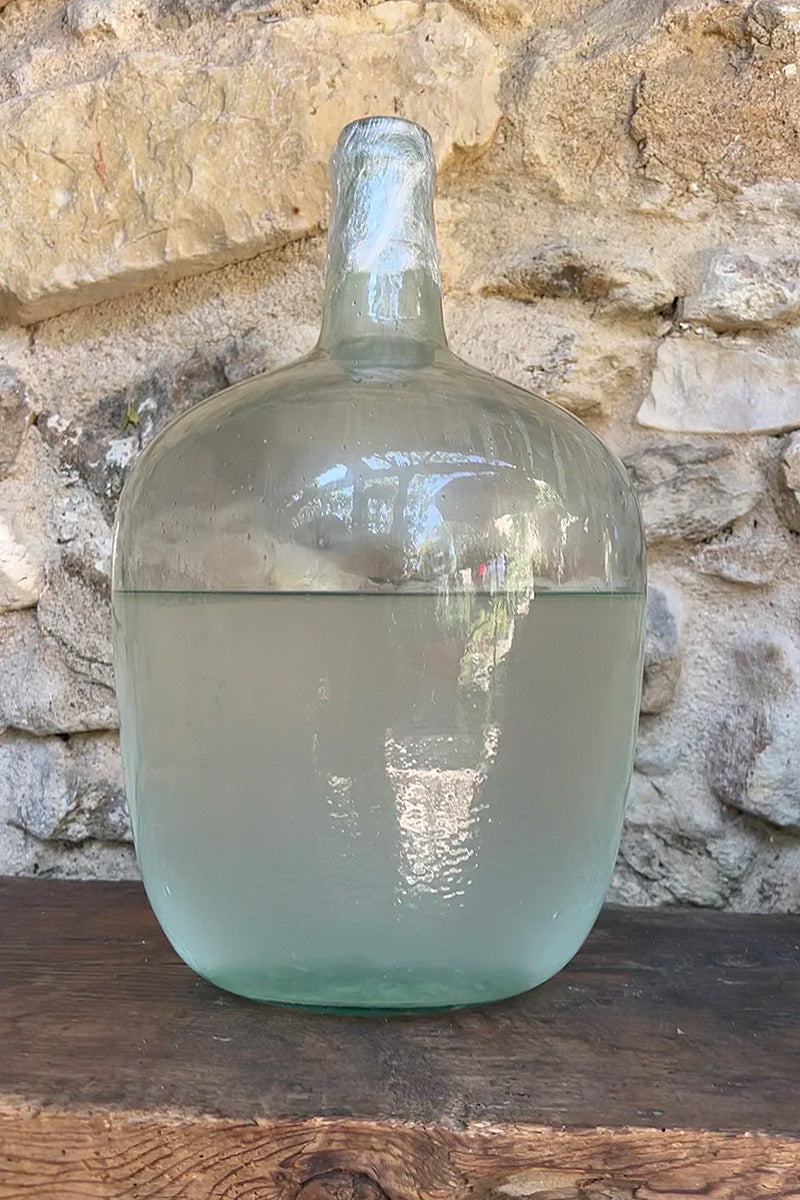Distillation of lavender, in search of the essence
By Amelia Perez
Every summer for years, we take advantage of the flowering of our lavender plants to distill and thus obtain essential hydrolate . The process of evaporation by heat and subsequent condensation by cold using a still serves as our R&D, complementing our activity of making artisan soaps.
 Home distillation serves as our R&D, complementing our artisan soap making activity.
Home distillation serves as our R&D, complementing our artisan soap making activity.
In our shop-workshop in Santiuste de Pedraza, Segovia, we have planted the lavender angustifolia variety, which flowers between July and August and lasts approximately one month. This year we have been forced to delay the process for a few weeks due to the high temperatures, but we have not been able to resist taking advantage of a great harvest.
Our intention is to distill the lavender to obtain the hydrolate with essential oil (hydrosol).
A hydrolate (or distillation water or aromatic water) is an aqueous condensation product obtained after the distillation of a natural raw material (lavender), generally vegetable, which remains after steam distillation.
Although regularly used in descriptions of beauty products and articles, the word hydrolate is not recognized by the Royal Spanish Academy and is derived from the French 'hydrolat' . Floral waters, obtained from flowers, such as rose water, are also part of the hydrolates .
The process
1. Pruning
It all starts early in the morning, when the plant is cool and has a higher concentration of aroma. With a hoe in hand, we take out the lavender with its stem and fill the wheelbarrow. Afterwards, we separate the lavender that we are going to use to decorate and we make little bundles to hang to dry.


2. Preparing the still
Our still has a capacity of 40 litres. It is a small still compared to those used in professional essence extraction. To obtain 15ml of lavender essential oil, approximately 1.4 kg of fresh lavender branches are required .
The first thing we do is fill the boiler with water. We make sure that the cooling circuit is working correctly. This consists of a condenser, or a copper tank filled with water that has the function of cooling the water surrounding the coil that causes the condensation of the steam generated by the boiler. Fresh water is introduced through the lower part of the condenser by means of a cooling circuit driven by a small water pump that fills the tank from below and empties it through a pipe at the top that expels the hot water into another container.


Unlike alcohol distillation stills, those used for the distillation of essential oils have a tank between the boiler and the dome where the aromatic plants, stems or leaves to be distilled are deposited.
In our case we filled it with 1.75 kg of lavender branches in bloom, cut to facilitate their introduction into the tank. Once full, we covered it with the dome and completed the circuit between the dome and the coil with the “swan neck”. Everything is ready to light the fire in the boiler.


The last step before starting the distillation is to close any possible leaks through which the vapor containing our precious essential hydrolate could escape. To do this, we have prepared about 150 gr. of bread dough that we apply to the joints of the still. As the still heats up, the dough expands, sealing any vapor leaks.


3. Distillation
After about 15-20 minutes, a rich lavender aroma begins to be perceived in the air. We are attentive to our demijohn as it fills, drop by drop, with essential hydrolate . During this process, we can devote our attention to any other activity, as long as we check that the water in the condenser is always cool so that the distillation can be completed.

4. The hydrolate
It took about two hours to fill our demijohn after the distillation began. If we look closely at the surface of the hydrolate , we can see that the upper part, approximately 1 mm thick, is darker, this is the essential oil. Physics separates the liquids because the density of oil is lower than that of water. This confirms the tremendous amount of lavender needed to extract a few drops of essential oil.
Lavender hydrolate has calming effects and is recommended for sensitive and reactive skin, as well as for any skin type after shaving or waxing.

At night, I love to apply the hydrolate to my face with a cotton pad, as well as the chamomile infusion, which I alternate depending on the day. You can read about the chamomile routine in our article It's time to take care of ourselves .
After carefully and calmly cleaning my entire face, I wash my face with any of the natural soaps recommended below .

Our recommendations
Lavender soap , carrot soap , olive soap with aloe vera , calendula soap , and rosehip soap are formulated to keep our face clean and bright . They are very nourishing soaps that we recommend for extremely sensitive and dry skin.
Rosemary soap , aloe vera olive soap , calendula soap , lavender soap and argan soap contain regulating ingredients, which we recommend for oilier skin.

7 comments
Gracias Marisa, es un proceso muy bonito. Me alegra saber de su éxito con la destilación. Que bonito Chubut. Saludos desde España.
Hola. Hermoso articulo. Hoy terminé mi primera cosecha de lavandas, y realice una destilación en un alambique de 50 litros.
Obtuve un rico aceite de 2 kg aprox de ramas. Fueron 40 ml mas o menos. Y tambien el hidrolato. Quedé muy contenta con los resultados.
Soy de Patagonia. Chubut. Argentina
Hola. Hermoso articulo. Hoy terminé mi primera cosecha de lavandas, y realice una destilación en un alambique de 50 litros.
Obtuve un rico aceite de 2 kg aprox de ramas. Fueron 40 ml mas o menos. Y tambien el hidrolato. Quedé muy contenta con los resultados.
Gracias por sus comentarios. Por la zona se pueden comprar los planteles en El Ejidillo, tienen vivero en Valdesimonte, Segovia.
https://www.ejidillo.com
Gracias Amelia, por tan buena explicación tengo una pequeña parcela y la plantaría de Lavanda, sabes donde podría adquirir la simiente, ¿sí es que se reproduce con simiente?
Gracias
Pepe